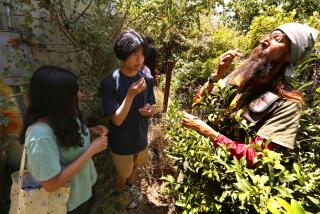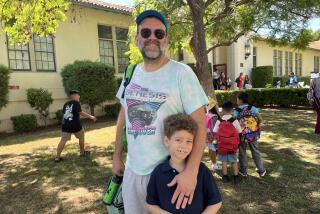Ages Mix at Tiny School
Inside the cluttered library of 32nd Street Magnet School, a kindergarten-through-12th-grade campus, a magazine rack displayed an issue of Seventeen, with articles such as “Straight vs. Curly, What Boys Want.” The teen magazine sat next to an issue of Highlights for Children, which featured an article on hopscotch.
Just outside, a second-grade boy played kickball with classmates and almost bumped into a high school student, who towered over him.
Two elementary school girls entered a bathroom, in which stalls were coated with cream-colored paint to cover some profanities now barely visible. In one stall graffiti read: “For a good time call....”
This tiny, fenced campus in the shadow of USC, south of downtown Los Angeles, is home to two magnet schools under one principal and one name. A 270-student high school math, science and technology magnet moved onto the campus about 10 years ago, joining a 700-student kindergarten-through-eighth-grade visual and performing arts magnet.
It is one of only five campuses in the Los Angeles Unified School District to have all grade school ages. Statewide, there are only 65 public schools with kindergarten-through-12th-grade enrollment, and most have fewer than 1,000 students, according to data from the California Department of Education.
Foshay Learning Center, an academically acclaimed campus in South-Central Los Angeles, is the largest such school in the state, with 3,600 students.
Kindergarten-through-12th- grade campuses are often effective in relatively small settings like 32nd Street, said David Marsh, associate dean of USC’s Rossier School of Education. Such environments allow teachers to get to know students as they grow older, he said.
“Of course we need to protect younger kids from things older kids do,” he said. “But we can’t take that concern and let it justify large schools that isolate kids of a particular age.”
Marsh, who has visited 32nd Street School, said it provides a family-like environment where upperclassmen often act like older brothers and sisters to younger children.
Although age groups are separated for academics, the students cross paths between classes, during the nutrition break, before school and during assemblies.
For the most part, staff members say, everyone gets along. Older students tutor younger students after school. Big kids shield little kids from bullies. Impressionable children admire trendy teenagers.
But allowing a wide range of ages on such a confined campus has caused concern among some parents, such as Dan Hart, who has a 10-year-old foster daughter, Valerie Vidal, at the school. Once, Valerie asked why girls walked around with the top buttons of their pants undone. He said of the provocative fad: “That’s their style, I guess. But you’re not going to do that.”
During lunch, called nutrition, high school students take over the back of the campus, sitting at circular tables. Elementary students sit at covered, outdoor lunch tables near the front of the campus. Middle school students congregate at benches in between peach and orange bungalows that are covered with murals depicting ballerinas, flowers and musical notes.
“If a high schooler hangs here, they know they can’t hang here, because this is our spot,” said Tatiana Williams, 13. “Not according to teachers, according to us.”
Perhaps concerns about age intermixing would be lessened if the campus were expanded, said Timothy Miller, director of middle schools for local Subdistrict G, who oversees 32nd Street. The school lacks a sports field, playground equipment, a gymnasium and an auditorium large enough for everyone. Students use USC’s gym and library facilities.
“Because it’s a K-12 program, there are such diverse needs,” Miller said. “Our younger kids needs swings and teeter-totters.... High school students need baseball fields and a track.”
Miller said he plans to ask the district to build additional facilities on the campus if voters approve a $3.3-billion L.A. Unified school construction bond in November and receive additional funds from a $13-billion state school bond on the same ballot.
Principal Gail Greer said parents often worry about the range of ages at the school, but then find out that it offers a caring, safe environment. Besides, because the school is home to two magnets, each with limited space and long waiting lists, anyone caught bullying or causing trouble may be sent to another campus.
Parents line up to apply for 32nd Street, which offers a range of outreach programs and tutors with the help of USC. As conceived 20 years ago, magnet schools like 32nd Street were intended to improve integration by offering specialized programs in areas such as math and science, art, language and the humanities to attract a diverse student body.
Greer said the campus operates on these rules: High school students take care of middle school students. Middle school students take care of elementary pupils. And elementary pupils tell on everyone.
And tell they do.
High school students “write bad things in the bathrooms,” Amani Odom, 10, said. “They’re not supposed to bring cell phones, but they do.”
“They make out everywhere!” said Brandon Bobo, 9. “Sometimes they mess with us and take our money in the bathroom if we’re alone.”
“They tease us. They say, ‘You’re very little,’ ” said second-grade student Alexis Mendez, 8. “Sometimes they say, ‘You’re ugly.’ ”
Tatiana Williams, a middle school student, explained the social pecking order. “If you talk to the high schoolers, then you’re considered popular,” she said. “But if you talk to the little kids, they think you’re a nerd and have no friends.”
High school students have their gripes too: “For nutrition, you just wanna walk around, and they’re running around and bumping into you,” said Nick Harrington, 16. But he added that it is nice having some youngsters look up to him.
The comfy campus enables teachers to get to know most students, and sometimes watch them grow from small children into young adults.
Senior Iris Casco, 18, has attended 32nd Street since kindergarten. She has a sister in 11th grade and two 12-year-old cousins at the school. She frequently checks up on them to make sure they are not being bullied and are getting good grades.
Joyce Melendez, 18, also a senior, said she sees how older students influence younger ones, for bad and good. For example, she often notices little girls caking on makeup.
But she goes out of her way to befriend some little ones and hug them. “It makes them feel good, because it shows them that even though we’re older, we can talk to them,” she said.
More to Read
Sign up for Essential California
The most important California stories and recommendations in your inbox every morning.
You may occasionally receive promotional content from the Los Angeles Times.










